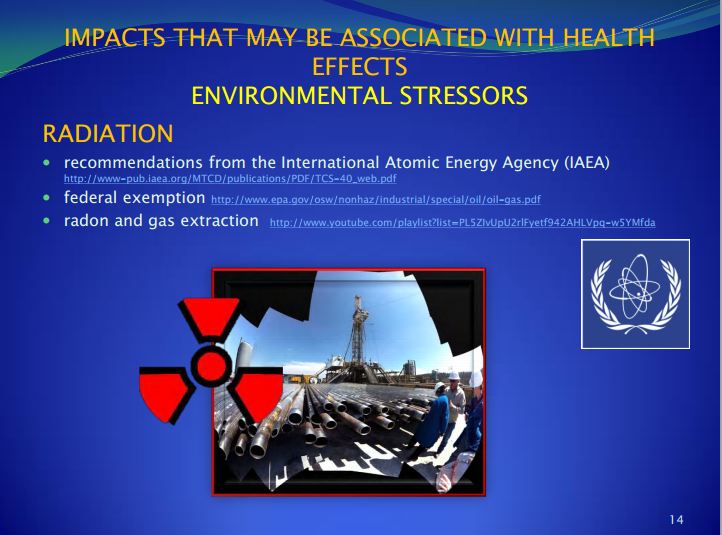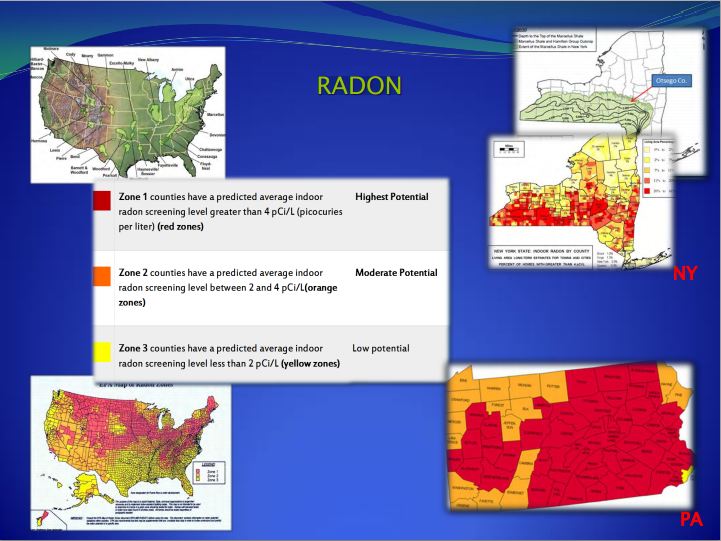Radon — #9 In “Top 10 Toxic Ingredients Used By The Fossil Fuel Industries” Series (2nd of a 10-part series) by Don Lieber, November 29, 2013, Planetsave
Radon is a colorless, odorless, tasteless radioactive gas which causes lung cancer. It is the second largest cause of lung cancer in the US after cigarette smoking. About 20,000 people per year die from lung cancer attributed to radon exposure according to the National Cancer Institute. Further, there is no known threshold below which radon exposures carries no risk. Radon exposure can come from a variety of natural sources. However, the newly-developed fossil fuel extraction methods collectively known as “fracking” (natural gas) represents a significant new and increased source of radon exposure to millions of citizens. Radon is released into local groundwater and air during fracking operations. It also travels through pipelines to the point of use — be it a power plant or a home kitchen.
The science behind radon release and exposure is complex but explained well here by Christopher Busby, the Scientific Secretary of the European Committee on Radiation Risk, who warns that Radon dangers from fracking “have not been addressed properly (or at all) by the environmental impact statements published by the operators, or by the Environmental Protection Agency in the USA.” The proliferation of fracking in the US has raised increased concern that the long-term public health consequences of radon exposure are being ignored….
The industry (and NYC Mayor Bloomberg) touts the development of fracking as an achievement for “clean energy” and American energy “independence.” The laws of chemistry and biology, however, tend to ignore patriotic soundbites, and Mayor Bloomberg is not doing New Yorkers any favors from importing newly fracked gas from Pennsylvania: the radon levels from wells in the Marcellus Shale are significantly higher than elsewhere in the US. This fact, combined with the short travel distance to end use in New York means that citizens throughout the most populated city in the US will now be exposed to more amounts of this highly carcinogenic gas than ever before…. “City and state leaders have failed to think through the consequences of promoting radon-laced natural gas, and they failed to heed clear warning signs that gas from Pennsylvania represents a major threat to the public health of New Yorkers,” said Albert Appleton, former commission of the NYC Dept. of Environmental Protection and senior fellow at the Cooper Union Institute of Sustainable Design.
Another industry expert, Marvin Resnikoff, a PhD physicist and international radioactive waste consultant, put it more succinctly. Using fracked gas from Marcellus, he said, will directly lead to thousands of new cases of lung cancer in New York. Long-term studies from diverse science, research, and public health organizations, such as this one from the Federal Office of Public Health, provide evidence to take these warnings seriously. Many of these studies provide evidence that indoor radon causes a significant number of lung cancer cases in the general population. Dr. Resnikoff cited the the lack of attention, however, given to radon dangers by the New York State Department of Conservation’s Environmental Impact Statement on the use of Marcellus Shale fracked gas. “In the entire 1400 page statement there is only one sentence containing the word “radon” and no consideration of this significant public health hazard.” Read his full report here.
Such government apathy runs contrary to the findings by the world’s leading public health and science organizations who have published very clear warnings. Organizations such as the World Health Organization, the National Institutes of Health, and the National Cancer Institute, all articulate a definitive, well-established connection between radon and lung cancer. …and yet, like the tobacco industry in years past, today’s fossil fuel industry denies the science. Thus, a spokesperson for the Marcellus Shale Coalition, a gas industry trade group, recently disputed the findings of the world scientific community about the dangers of radon: “Their claims are unsupported by facts and science,” says MSC spokesman Travis Windle. The Marcellus Shale Coalition’s website, it should be noted, makes no mention of the bloody lungs and painful bone metastases which, eventually, occur in end-stage lung cancer resulting from radon. Instead, it refers to the promise of “clean, job-creating American natural gas.” (Yes, the website actually says “clean.”) [Emphasis added]
Cochrane Alberta home tests high for radon by Lindsay Seewalt, November 28, 2013, Cochrane Eagle
It’s odourless, tasteless and invisible. It’s also the second leading cause of lung cancer, next to smoking, or the leading cause of lung cancer in non-smokers. And it just might be reaching dangerous levels in your home without you even knowing it. A radioactive noble gas, Albertans are among the last to know about radon — how long-term exposure to it in enclosed spaces (homes) can be lethal and yet how easy it is to mitigate. With the push by Health Canada to make November ‘Radon Action Month’, Cochranite and co-owner of Radon West, Renata MacQueen, is on a mission to raise awareness in Cochrane and surrounding municipalities. “Due to the geology of Southern Alberta, we are in a high risk area and the results we are finding have been consistent with that,” explained MacQueen, who estimates that over 40 per cent of the homes her company tests in Calgary, Okotoks and Canmore are testing high for radon. MacQueen explained that glacial till gets pushed into Southern Alberta by glaciers from such areas as Alaska, Northern B.C. and the Yukon, where there are high levels of radon. “In Canada, radon is measured in a unit called a Becqueral per meter cubed (Bq/m3)…we have been consistently finding levels above Health Canada’s actionable 200 Bq/m3, while testing communities from Banff all the way down to Lethbridge.”
MacQueen’s own Cochrane home tested at a staggering 2,491 Bq/m3. Her sister and business partner, Karin Dumais, also tested high, 322 Bq/m3, in her Okotoks home. This prompted the women to become certified in 2013 as Canadian-NRPP Certified Measurement Professional and Canadian-NRPP Certified Mitigation Professional; the women are two of the six licensed radon measurement and mitigation professionals in the province. One Cochrane woman has broken the record for Radon West. Her home tested at 3,441 Bq/m3. Although she mitigated her home in the fall of 2012 and continues to regularly test her radon levels, her doctor has referred her for a CT scan, as she lived in her home for so many years with no idea she was being exposed to such high levels of radon. “I was horrified,” said the women, who wished to remain anonymous. “I couldn’t even be in the house until it was mitigated.” The women said what concerns her the most is the lack of awareness in Alberta — how so few people she talks to actually know about the side effects of long-term exposure to high levels of radon in their homes. “Health Canada has had a national program in place since 2008,” explained Kelley Bush, head of radon education and awareness for Health Canada. “With radon, because it’s a long-term health concern, people are apathetic about it…the risk of radon-induced deaths is the equivalent of all accidental deaths — if people put their lifejackets on or check their smoke detectors, they should check their homes for radon levels.”
Health Canada launched a cross-Canada survey from 2009-2011, testing some 16,000 homes; an average of seven per cent of homes tested over the 200 Bq/m3 acceptable radon level, as per Health Canada guidelines. Health Canada recommends people purchase a long-term (91-day) radon test kit. The kit can be purchased through Radon West or at other retailers and the cost is $45, including lab fees. Other short-term testing options are available. The cost to mitigate a home (installation of a radon fan by a licensed professional) ranges from $1,800-$3,000. This will be made more cost effective when Alberta adopts the changes that were made to the National Building Code in 2010. “A stubbing-in of the underground portion of a radon mitigation system in now part of the National Building Code for new construction and we are hoping that Alberta follows suit soon,” explained MacQueen, adding that people who purchase a radon level testing kit should test at the lowest living level of their home (the basement). “Through radon can come from other sources such as water and granite, your greatest risk is from soil gas and your first step is always to test for radon in the air.” [Emphasis added]
To learn more about radon, visit healthcanada.gc.ca/radon or takeactiononradon.ca.
To reach Renata MacQueen, visit radonwest.com.
[Refer also to:
Radon gas leaks in coalbed methane fields in Australia spark call for probe
Silent killer: Health Canada urges testing homes for cancer-causing radon
Radon threats are grounds for precaution
Slides above by Larysa Dyrszka MD, September 2013


